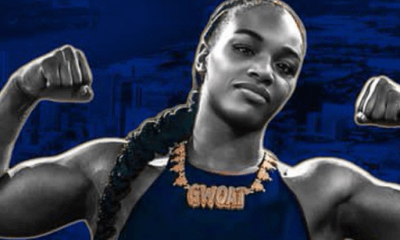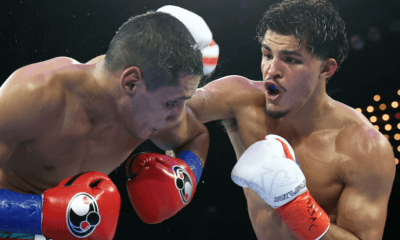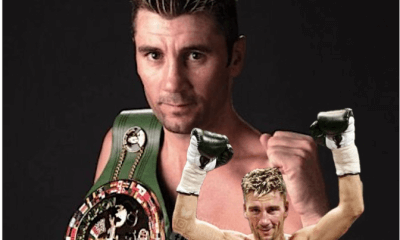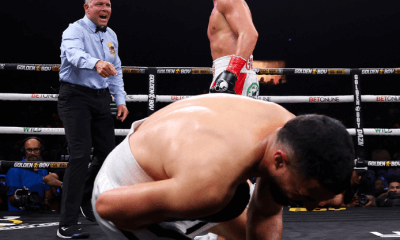Featured Articles
Bernard Fernandez Reflects on His Special Bond with George Foreman
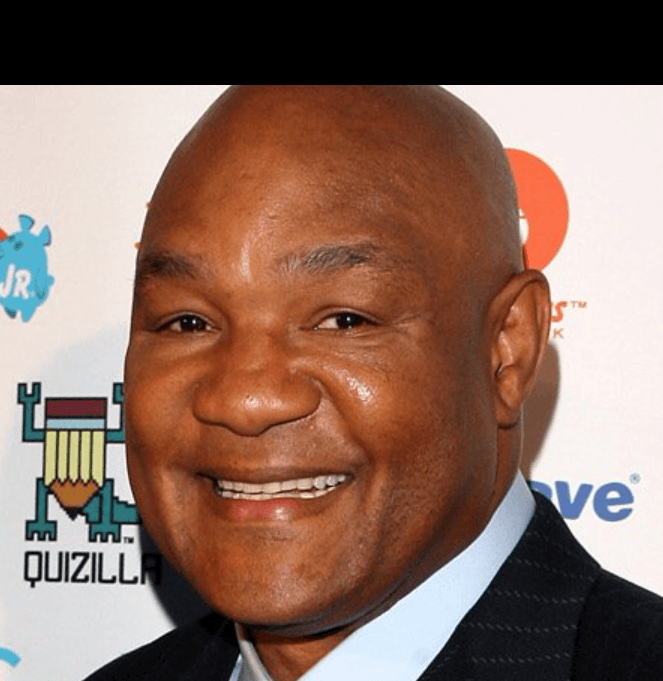
Bernard Fernandez Reflects on His Special Bond with George Foreman
For pretty much the entirety of my career as a sportswriter, I have doggedly adhered to the principle that there is a line separating professional integrity from unabashed fandom, and for me to cross it would be a violation of everything I believed in as a representative of whatever media outlet I was writing for at the time. In 50-plus years, only once did I cross that line. It was when I was in Canastota, N.Y., for an International Boxing Hall of Fame induction weekend and I had submitted the winning bid in a silent auction for an autographed photo of the great Carmen Basilio, being hoisted onto the shoulders of trainer Angelo Dundee and another cornerman after winning a title bout. I have that photo, which also was signed by Angelo, hanging on the wall of my apartment.
I broke my self-imposed rule by asking Carmen to pose with me holding the photo because he was my father’s favorite fighter, and thus mine when I was a little kid watching the Gillette Cavalcade of Sports Friday Night Fights with my dad, a former pro welterweight and Navy veteran of World War II in the Pacific before he became a much-decorated police officer. Anyway, Carmen was long-since retired and I chose to believe that on the grand scale of professional propriety, my posing with him was nothing more than a small blip on a very large radar screen.
But with the shocking news that George Foreman had passed away on March 21, at the age of 76, it suddenly occurred to me that my idealistic principles have forever prevented me from having an autographed photo of Big George hanging on the same wall with the one of Basilio, which I no doubt will regret to my dying day. If I had bent my own standards of how a sportswriter should act in his dealings with one of his interview subjects, I might even have had one of George and I together, side by side, as is the case with any number of my colleagues who asked for and were granted photo op access to the famous athletes they covered.
Why do I now place George Foreman in a separate category from so many other elite fighters I have covered during my career? Had I not rigidly held to my belief that it was unprofessional and maybe even a bit unethical to cross that inviolable line, I might now have photos of myself standing alongside Muhammad Ali, Joe Frazier, Lennox Lewis, Sugar Ray Leonard, Roberto Duran, Marvelous Marvin Hagler, Tommy Hearns, Bernard Hopkins, Oscar De La Hoya, Roy Jones Jr. and Felix Trinidad, not to mention such legends of other sports as Willie Mays, Mickey Mantle, Walter Payton, Wayne Gretzky, Wilt Chamberlain, Julius Erving and the quarterbacking family of Archie, Peyton and Eli Manning.
I had, of course, covered a number of Big George’s fights, but although he knew of me, it was not to the extent that he considered me to be a friend. All that changed, however, through the intercession of a mutual friend, boxing publicist Bill Caplan, whose relationship with George was longstanding and so deeply ingrained as to be almost familial.
My newspaper, the Philadelphia Daily News, had sent me to Los Angeles to cover a bout in which Julio Cesar Chavez was to fight Philly’s Ivan Robinson. Despite increasing pain, I somehow managed to file features on both main-event participants in the days before fight night prior to my arrival at the Staples Center in a condition that had gone from bad to worse. Bill noticed my distress in the press room and said he was going to get a ringside physician to check me out. “Maybe after the fight I came here to cover is over,” I told him, grimacing through gritted teeth. But Bill insisted that I get a medical opinion, and quickly, and the doctor who took my blood pressure said it was at a near-stroke level and that I needed to be transported by ambulance to a hospital ASAP. In the emergency room, it was determined that I was suffering from an unpassed kidney stone, a problem I had had several times previously, but not to this extent. I did not cover the fight I had come to see, of course, but I was able to make it back home alive and reasonably well before receiving additional treatment.
George Foreman did the foreword for my first boxing anthology, Championship Rounds, but he consented to do so only after he consulted with Bill Caplan to inquire if I was a writer who could be trusted not to twist his words to fit my own narrative. Bill told him I was a fair guy and that he should do the foreword once he had read the manuscript and deemed it worthy of an endorsement. It didn’t hurt that when I spoke with George by telephone, I remarked that he “owed” me. “Why do I owe you?” he asked, seemingly amused. “Because I bought two of your grills,” I replied, which drew the chuckle from him I had hoped to get.
More than a few of my colleagues at various media outlets can accurately say that George considered them to be his friends, but my relationship with him continued to grow. It didn’t hurt that I was on very amicable terms with his younger brother Roy Foreman, who lives just outside Atlantic City, and whenever I needed to speak to George directly he either answered right away or returned my call at his earliest convenience. I also don’t think it hurt that my father had once appeared in a primary undercard bout of a show in San Diego in the 1940s that was headlined by the great Archie Moore, who would later serve as one of George’s most trusted advisers. Before George’s very respectable but losing performance against heavyweight champion Evander Holyfield, the challenger confided that “Archie is the only one who can tell me anything. When Archie Moore takes you to the side to tell you something, you can’t argue because he knows. I can’t argue with Archie Moore. When he tells me something, I have to say, `Yes, sir, that’s right.’”
Maybe the only person George trusted as much as the “Old Mongoose” was Bill Caplan, and it was Bill who told his dear friend of the abject grief my family and I were enduring after my wife, who had been battling stage 4 pancreatic cancer, passed away on May 5 of last year. I would prefer not to divulge any details of something that shall forever remain private, but what George did in support of me and mine, and to honor the memory of a great lady who he never met, went above and beyond.
I included stories I did on George in three of my five boxing anthologies that already are in print (a sixth likely will come out this June), and I’d like to believe that our connection was solid enough that he shared the sort of insights that revealed him to be so much more than a devastating puncher inside the ropes. He was a quality human being in his everyday life, an individual who was widely admired and deserved to be recognized as such. But even if that were not the case, he would stand nearly alone for his ability to hit as hard as any heavyweight who ever lived. In recalling what it was like to share the ring with Big George in the epic “Rumble in the Jungle,” which Ali won by eighth-round knockout on Oct. 30, 1974, the victor said, “If you take any two heavyweights you can think of, and multiply (their punching power) by two, that’s George Foreman.”
Maybe Foreman might have fared better in that much-hyped bout in Kinshasa, Zaire, had he paced himself a bit more, but then that would not have been in keeping with his long-held belief that it did not pay for a powerful puncher to parcel his energy in measured doses.
“When you’re a puncher, it’s a real mysterious, almost magical thing,” he told me. “Guys who can’t punch, one thing they got to have is a lot of bravery because they knew they had to go 10 rounds, 12 rounds, 15 rounds almost every time. Punchers live with the fear if a fight keeps going another round, another round, they’re somehow going to lose. Every fight I ever had, I went for the knockout and nothing else. I didn’t really think I could win a decision. Even when I won on points, I felt like I failed.”
But even Big George didn’t have enough power to kayo the Grim Reaper indefinitely, although he might have dared to believe he could make that happen by dint of his indomitable will. After he won his first heavyweight championship, dethroning Joe Frazier by registering six knockdowns in less than two rounds on Jan. 22, 1973, in Kingston, Jamaica, the new king of the big men said, “All of a sudden I’m beating a guy like Joe Frazier, who could punch like he could and never stop coming at you? I left there thinking, `Nobody can stand up to me.’ I just believed that if I caught anybody with a right uppercut or a left hook, he’s gone. I could knock anybody out with either hand. It seemed impossible to me that I could lose.”
In posting a 76-5 career record with 68 victories inside the distance, Big George didn’t lose often. Now that he’s taken his earthly leave, I can only regret the fact that I didn’t cross that line and ask him to pose for a picture with me. I hope he somehow knows that I shall forever be in debt for the graciousness he exhibited toward my wife and my family when we needed just such a gesture not only from a legendary fighter, but a true friend.
Editor’s note: Bernard Fernandez entered the International Boxing Hall of Fame in the Observer category with the class of 2020. The greatly-admired publicist Bill Caplan, now in his late 80’s, entered the Hall in 2022.
To comment on this story in the Fight Forum CLICK HERE
-

 Featured Articles3 weeks ago
Featured Articles3 weeks agoResults and Recaps from New York Where Taylor Edged Serrano Once Again
-

 Featured Articles3 days ago
Featured Articles3 days agoThe Hauser Report: Zayas-Garcia, Pacquiao, Usyk, and the NYSAC
-

 Featured Articles2 weeks ago
Featured Articles2 weeks agoResults and Recaps from NYC where Hamzah Sheeraz was Spectacular
-

 Featured Articles3 weeks ago
Featured Articles3 weeks agoFrom a Sympathetic Figure to a Pariah: The Travails of Julio Cesar Chavez Jr
-

 Featured Articles3 weeks ago
Featured Articles3 weeks agoPhiladelphia Welterweight Gil Turner, a Phenom, Now Rests in an Unmarked Grave
-

 Featured Articles1 week ago
Featured Articles1 week agoManny Pacquiao and Mario Barrios Fight to a Draw; Fundora stops Tim Tszyu
-

 Featured Articles1 week ago
Featured Articles1 week agoArne’s Almanac: Pacquiao-Barrios Redux
-

 Featured Articles4 weeks ago
Featured Articles4 weeks agoCatterall vs Eubank Ends Prematurely; Catterall Wins a Technical Decision




